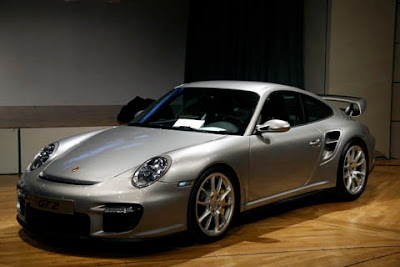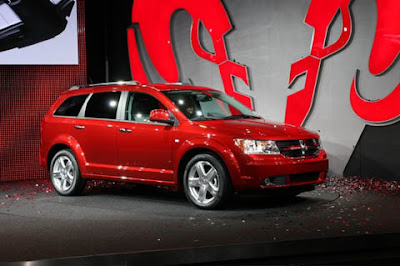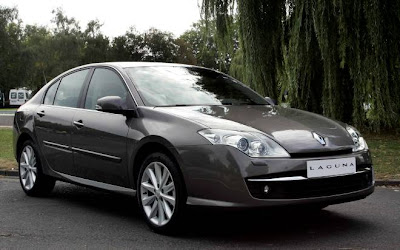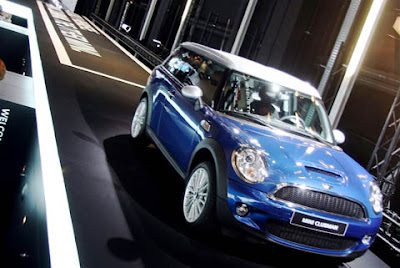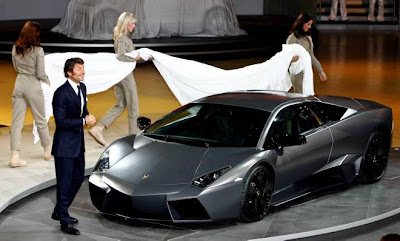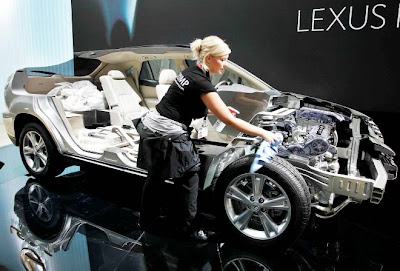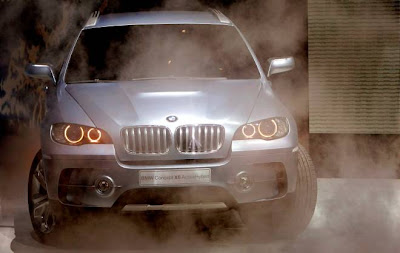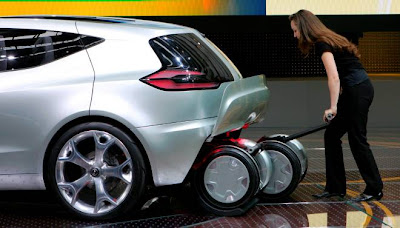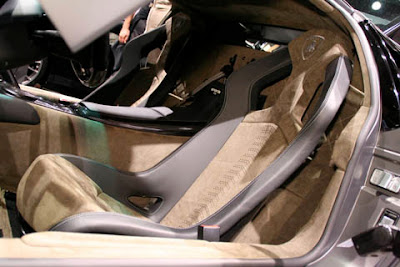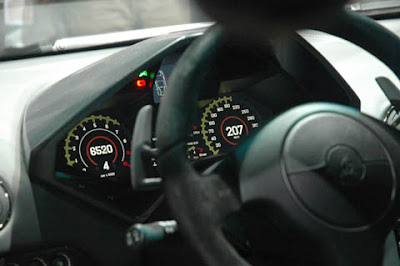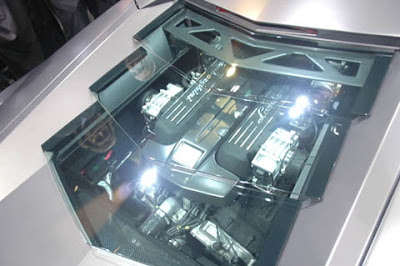Tuesday, September 11, 2007
2007 Frankfurt Auto Show
Labels: BMW, Bugatti, Citroen, Dodge, Ferrari, Ford, Frankfurt Motor Show, Hyundai, Kia, Lamborghini, Mercedes-Benz, Mini, Mitsubishi, Nissan, Opel, Porsche, Renault, Saab, Subaru, Suzuki
Frankfurt Auto Show: Kia Kee Coupe Concept





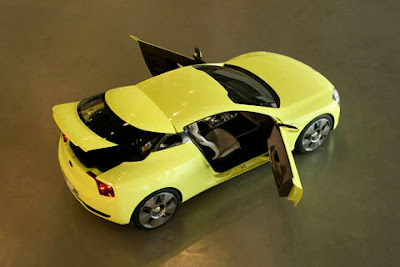
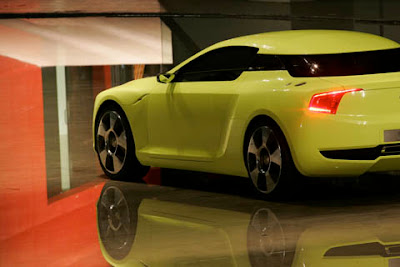

KEE concept heralds "new look" for the future of KIA
More than any other car-buyer, the sports coupe enthusiast knows instinctively when a car is right, when it is suited to its purpose. Shape, proportion, stance and both tactile and emotional aspects all add up to a car that stirs the blood. At the 2007 IAA in Frankfurt, Kia has revealed just such a car.
The KEE is a combination of all of those elements. It is a harmonious blend of everything that sets the sports coupe apart from the more functional vehicle – the vehicle that has a range of activities to undertake and a palette of needs to take into account for its owner. The sports coupe is single minded. It is about driving, pure and simple. It is about appearance, performance, emotion.
Yet KEE is more than just a svelte, exciting sports coupe concept. It is also the dawn of a new design language for the Kia brand – a language that will speak to motorists across the world about the Korean company's intention to become one of the major automotive names over the coming years.
Chief Design Officer, Peter Schreyer and his Frankfurt design team – headed by Gregory Guillaume – set out to make KEE a landmark car in Kia's history. It is no coincidence that its name plays on the word 'key' because that is how essential KEE is to the future of Kia. KEE also acknowledges the Chinese and Korean word ´Ki`- the cultural concept for life-force or spiritual energy.
KEE embodies Kia's desire to create a family of cars that will be instantly recognisable on the road and will have simple yet sophisticated appeal in the showrooms. Whether wide-eyed admirers of this new generation of vehicles are existing Kia customers – wise to the dramatically improved quality and traditional strong value of the current range – or entirely new audiences they will immediately recognise a range of cars aimed at those who enjoy driving and seek the perfect machinery to deliver that experience.
Schreyer commented:"KEE has to communicate a design language that will be seen on all future Kia products. That language has to be stated in certain elements of the visual representation – lines, shapes, details. But it has to be consistent and easy to understand. It must be visually strong and purposeful but it must be capable of being transferred from this sports coupe concept to a city runabout, a family saloon, a load-lugging MPV or a go-anywhere SUV.
"It was essential Kee should consist of a rhythm of lines – controlled, clean, pure. It had to have good, classic proportions and be well balanced," he added. This is the future for Kia design – it must display the purpose, the function whilst still being capable of delivering an emotional aspiration.
With its broad stance and low profile KEE, a new interpretation of a 2+2 coupe, has a simple yet distinctive outline thanks to its long sweeping bonnet, slightly lengthened cabin with striking graphic treatment, sculpted flanks and strong, yet almost hidden, swage lines.
Beneath the powerful and unique appearance are a host of fine details all hinting at the car's true purpose and harmonising to create a sophisticated design entirety. Whether it is the milled aluminium B-pillar visible through the panoramic grey-tinted glass, the distinctively individual 20 inch wheels and hand-cut Continental tyres or the small touches such as the electronic micro-switch door release set into the side-window glass, the clamshell rear hatch opening on electronic dampers or the unique front windscreen shape that mirror so many other details on the KEE, it is clear that this car has been lovingly created by people who care for design.
Inside – KEE looks and feels like a sports car that the keen driver will instantly feel comfortable and at ease in, with a cabin designed for maximum focus on driving. Clustered straight ahead, the main dials and controls are simple and straightforward utilising Kia's new standard red-orange illumination.
Behind the square-bottomed steering wheel are paddles to shift the six-speed sequential gearbox. Instead of a standard gear stick an ergonomically designed lever sits atop the milled aluminium centre console and requires only a nudge forward or backward to select drive mode. And the top of the computer mouse-like lever flips up to reveal the electronic starter button.
Again, the design team have concentrated on producing a realistic sports coupe – not a flight of fancy. Every element of its design should be clear, easy to understand and to use. All the main controls are fly-by wire, but their feel in operation has been created to deliver a sense of traditional operation. For example, the toggle switches mounted on the dashboard – echoing the DNA of generations of sports cars – let you navigate intuitively through the interface menu of the info-media center.
After pressing the starter button the driver will immediately recognise the throaty roar of a V6. The next generation 2,7 litre MUE-II engine, producing 200 ps, delivers instant response, enormous flexibility and scintillating performance on any kind of road.
Kia Kee uses light-weight aluminium or plastic panels and components wherever possible in order to allow the emphasis to remain on rapid and controlled progress that means simple fun and driving pleasure. This results in a low kerb weight with excellent balance biased towards the front to deliver neutrally safe handling. Yet KEE could be built with rear wheel drive or even all-wheel-drive allowing Kia to add to its growing range as its brand develops its reputation amongst a more exacting audience.
"All the main interior surfaces are covered in a semi-suede-like microfibre material and the body-hugging sports seats use a heard-wearing but distinctive metallic-finish cloth," explained Salome Etienne – one of the KEE's interior design team.
And continuing the real-life functionality of KEE, the rear of the passenger cabin is sufficiently spacious to allow four adults to travel in the vehicle when necessary. KEE is not intended to be a four-seat coupe but Kia knows that real people have real needs and the brand has no intention of moving into the exotic sports car territory that others so amply fill. And there is even space for a useful amount of luggage!
But echoing its concern for the comfort and convenience of its customers the designers have sought to ensure that when the need arises those rear passengers will not be confronted with a problem so common on most 2+2 coupes. "When the rear clamshell hatch is raised the roofliner stays fixed in place to ensure that passengers do not come into contact with the structure of the hatch when it is closed again," said Raphael Le Masson – the other interior designer.
Exterior designer Fabien Coradin said: "This car is about passion and energy. It is not an act of reason. Buying a sports car is not a logical choice and that is what we wanted for this car. It may not have been the normal reason behind most Kia purchases in the past – but the brand is changing and this car shows what Kia can be in the future. But we do recognise that functionality has a part to play."
Uncluttered, pure and timeless in execution yet modern, effective and usable in purpose, KEE represents a new ethos for the Korean firm. With KEE the entire design team is laying open its mind and its heart. This car stands as a clear indication of KIA's design philosophy and how it sincerely wish Kia to be viewed – exciting, appealing, creative, aspirational, beautiful and yet functional, purposeful and realistic.
Gregory Guillaume, Chief Designer Europe, commented: "This is a starting point. It shows how we think and what we want to do – appeal to the emotional side of our audience and bring that balance of purpose and emotion into the Kia design language. With KEE we are irrevocably heading off on our chosen path..."
KEE is the first step towards a new family look for Kia vehicles underscored by a focus on design and although KEE is primarily a concept vehicle it is one that could easily go into production should public demand dictate. KEE lays down very clear indications of how Peter Schreyer and his team intend future Kia vehicles should look and displays elements that its creators will transfer to future products. Presented on the strong frontal design with its distinctive headlamps and eye-catching LED cluster, the new style grille will become the new face of KIA across the product range.
He commented: "Kia have given me – and our design teams – a fantastic opportunity. Seldom is a designer allowed to shape the entire personality of a brand, given a clean sheet of paper and told to create the future. KEE is the first step on the road and I am so excited about the potential this journey can create."
"Although KEE is a sports coupe it could have been anything. We have already seen elements of our design development in Mesa and Kue shown at successive Detroit shows. Cee'd and its concept spin-offs including the ex_cee'd cabriolet have also started the process. But KEE is central to our future.
"It is our keystone to the future family we want to create. There is nothing in KEE's design that cannot easily and readily be transferred to production vehicles. There is nothing in KEE that I would not be prepared to see in future production vehicles. This car stands as a clear indication of our philosophy for vehicle design and as a surest possible signpost to the type of vehicles we shall be bringing to showrooms in the very near future.
"I want motorists to be able to identify Kia cars almost unconsciously. It doesn't matter what type of vehicle they see – right across the Kia range there should be a very obvious style and image that will encourage drivers to identify with the Kia brand and instantly understand the function of the vehicle at the same time as they admire its lines," he added.
KEE ultimately serves the Kia brand on a number of fronts – a design exercise for a sports coupe that currently does not feature in the company's line-up. No plans exist to put the car into immediate production but media and public reaction will be closely monitored.
It also allows Schreyer and the entire design team to present their thinking for a family appearance and design language to both internal and external audiences. In this respect KEE is the first stage in an on-going process that will be refined and re-examined but will stay true to the core elements of design contained in the car.
Perhaps most importantly KEE is a simple corporate statement to the motoring world that Kia is a brand underpinned with quality and reliability and now on top of that comes the emotional element of design. The future for Kia products lies in balance, clarity and purpose, and KEE, our latest show car embodies that philosophy.
_____________
KEE Technical specification
Length 4325 mm
Width 1860 mm
Height 1315 mm
Wheelbase 2675 mm
Tyre size 245/40 R 20
Engine V6 2,7 litre MUE-II
Power 200 ps
Transmission six-speed automatic
Labels: Frankfurt Motor Show, Kia
Frankfurt Auto Show: 2008 Lamborghini Reventon
PRESS RELEASE:
Clearly a Lamborghini, but nothing quite like it. A super car without equals: the Lamborghini Reventón is a road vehicle with an extreme specification and, at the same time, a limited edition masterpiece – a coherent style, angular with sharp lines, inspired by the very latest aeronautics.With just 20 produced, each 1 Million Euro (without taxes) Lamborghini Reventón is a symbol of extreme exclusivity, yet still offering the extraordinary performance that makes the Reventón so unrivalled: under the completely autonomous design, the Reventón possesses the entire technical and dynamic competence of the twelve cylinder Lamborghini.
Lamborghini prides itself on being the extraordinary manufacturer of extreme super sports cars without compromise. Sensuality and provocation characterise every Lamborghini, with an aggressively innovative style. “However, the Reventón is the most extreme of all, a true automotive superlative. Our designers at the Lamborghini Style Centre took the technical base of the Murciélago LP640 and compressed and intensified its DNA, its genetic code,” affirms Stephan Winkelmann, President and CEO of Automobili Lamborghini S.p.A.
Born in Sant’Agata Bolognese
The Lamborghini Reventón has been entirely designed in Sant’Agata Bolognese, the original birthplace of the Lamborghini and the native home of every super car born under the sign of the bull. The design drawn up in Lamborghini’s Centro Stile (Style Centre) is fine-tuned in close collaboration with the Lamborghini Research and Development Department. Thus, the Reventón is not only “haute couture” but it also stands out for its elevated dynamism whilst being entirely suitable for every day use.
The Lamborghini Reventón is not destined to remain a one-off. A total of 20 Lamborghini friends and collectors will be able to own this extraordinary car and, naturally, enjoy the incomparable pleasure of driving it.
The name Reventón has been chosen according to Lamborghini tradition. Reventón was a fighting bull, owned by the Don Rodriguez family. It is included in the list of the most famous bulls ever and is known for killing the famed bullfighter Felix Guzman in 1943.
Inspired by the fastest airplanes
The present day Lamborghini models are distinguished by the clear language of their shape. The coherent proportions of the Murciélago and Gallardo highlight their power and dynamism. Sharp edges, precise lines and clean surfaces: these are ingredients of a style reduced to the essential. Each element is created exactly according to its function; ornaments and decorations are totally foreign to a Lamborghini.
With the Reventón the Centro Stile designers have coherently developed this philosophy, inspired by another sphere where speed and dynamism reign absolute: modern aeronautics, responsible for the fastest and most agile airplanes in the world. This has created an extremely precise, technically striking style with a new vitality: interrupted lines and contorted surfaces create a fascinating play of light, giving the car incredible movement.
Made of carbon fibre and precision
Although it is based on the extraordinarily successful Murciélago LP640, the exterior design of the Reventón is completely new. Just like the base model, the exterior is made of CFC, a composite carbon fibre material, which is as stable as it is light. The exterior components are glued and fixed to the body comprised of CFC and steel.
The front is characterised by the acute angle of the central ‘arrow’ and by the powerful forward-facing air intakes. Although they do not supply air directly to the turbine like an airplane, bearing in mind the 650 hp, an abundant volume of air is necessary to cool the carbon brake disks and the six cylinder callipers.
Characterised by coherent functions
Naturally, both doors on the Reventón open upwards – since the legendary Countach this has also been a symbol of the V12 Lamborghini product line. With their asymmetric configuration, the large air intakes below the doors provide an example of the extreme coherence with which a Lamborghini fulfils its function: on the driver’s side it is large to increase the flow of oil to the radiator. On the passenger’s side of the vehicle, the air intake is flat because in this case, it only has to ensure the flow below the floor. The aerodynamically optimised flat floor structure terminates at the rear with a diffuser featuring an accentuated shape. This guarantees excellent road grip and stability even at 340 km per hour.
In spite of the extreme and innovative language of its shape, the Reventón not only maintains all the strong features of the Murciélago LP640, but also offers further amelioration in terms of aerodynamics, the important engine cooling system, the air intake system and brakes. The airflow and the section of the variable geometry air intakes of the engine and the rear spoiler (also adjustable) have been modified.
Owners of the 20 examples will be able to test the performance of his or her Lamborghini in person.
Perfected to the ultimate detail
The engine hood made of glass laminate with open ventilation slits offers a glimpse of the beating heart of the twelve cylinders of the super car. The glass also features the marked arrow angle that characterises the design from the front to the rear spoiler. The Lamborghini designers’ love for detail is beautifully illustrated by the fuel tank lid: a small mechanical work of art, achieved by milling a solid aluminium block.
The combination lights transform the incisiveness of the design into light: the front features the most modern light-emitting diodes alongside Bi-Xenon headlights. Seven LEDs ensure continuous daylight while there are a further nine diodes for the indicator and hazard lights. Another technical innovation is found in the rear light LEDs. Because of the high temperature in the rear low part of the car, special heatproof LEDs are used for the indicator and hazard lights, stoplights and rear lights with a triple arrow optical effect.
A new body colour
Naturally, such a refined language of shape also demands an extraordinary colour. For the 20 examples of the Reventón, the designers from Sant’Agata Bolognese have created a totally new hue: Reventón, a mid opaque green/grey without the usual shine. However, thanks to the metallic particles, in the daylight this colour tone features surprising depth.
Opaque and brilliant colours for the wheel rims
This play of opaque and lustre is also featured on the wheel rims, especially created for the Reventón. Opaque carbon fins are screwed onto the black aluminium spokes, not only creating a visual effect with the precision of a surgeon’s scalpel, but a turbine effect also ensures optimum cooling for the powerful ceramic brake disks.
TFT display similar to an airplane
The same innovative force applied to the exterior design characterises the cockpit of the Reventón. Designed and created using Alcantara, carbon, aluminium and leather that comply with the top quality standards, the interior is inspired by the next generation cockpits: just like in modern airplanes, the instruments comprise three TFT liquid crystal displays with innovative display modes. At the touch of a button, the driver can choose from two vehicle information display modes. The instruments are housed in a structure milled from a solid aluminium block, protected by a carbon fibre casing.
The G-Force-Meter is also completely new: this display shows the dynamic drive forces, longitudinal acceleration during acceleration and braking, as well as transversal acceleration around bends. These forces are represented by the movement of an indicator on a graduated 3D grid depending on the direction and intensity of the acceleration. A similar instrument can be found in the airplanes. Formula One teams also use a similar device to analyse dynamic forces.
Customisable instruments
The instrument on the left of the speedometer associates the number of revolutions in the form of a luminous column with the display of the selected gear. Finally, every Reventón is equipped with a robotised e.gear controlled by two small levers under the steering wheel.
By simply pressing a button, the driver can switch to the second, quasi-analogical display, where the classic circular instruments, speedometer and engine speed indicator are configured in an equally innovative way and transformed into luminous pilot lamps with varying colours. The G-Force-Meter naturally remains at the centre in this display mode.
Electronic system developed entirely by Lamborghini
All this is possible thanks to the fact that the entire electronic platform of the Reventón, together with all the control devices, has been autonomously developed by the Lamborghini experts.
The same process for integrating the electronic displays in the car was applied to the Lamborghini Engineering Department.
From the conception of the very first radical ideas, the entire Reventón has been developed in Sant’Agata Bolognese thanks to tight teams of remarkably creative experts. An extremely refined and efficient process was employed: CAD design and development, creation of the prototype in the Prototype Department, all carried out under the constant supervision of the Research and Development Department’s technicians and testers.
Atelier of creativity and high efficiency
Inaugurated in 2004, the Centro Stile is dedicated to design and characterised by a high degree of efficiency: an “atelier” of creators, designers and prototype constructors, who encapsulate the Lamborghini culture and spirit by using their remarkable skills to create aesthetic innovation.
The Centro Stile is located in a 2,900 square two-storey building. The large pavilion houses two test floors and related production and analysis equipment, while other rooms are set aside for the most advanced computerised workstations for designers and a style-model construction workshop. The Centro Stile is also closely linked to the nearby Engineering Department: the direct line between the Lamborghini development departments guarantees that ideas rapidly become reality.
Creativity and production under the same roof
The Lamborghini Reventón is a practical illustration of the streamlined functionality and efficiency characterising the Centro Stile: it took less than a year to progress from the first ideas to the finished car. The complete design process from the first sketches on paper, to three dimensional computer models with 1:10 or 1:4 scale, right up to the real size prototype is organised around streamlined, fast, efficient work groups. Thanks to the Centro Stile, for the first time in its history, Lamborghini is now able to create its own style philosophy in-house without having to rely on any external collaboration.
The 20 units will be manufactured in Sant’Agata, using a production process characterised by artisan perfection and rigorous quality standards.
Labels: Frankfurt Motor Show, Lamborghini








